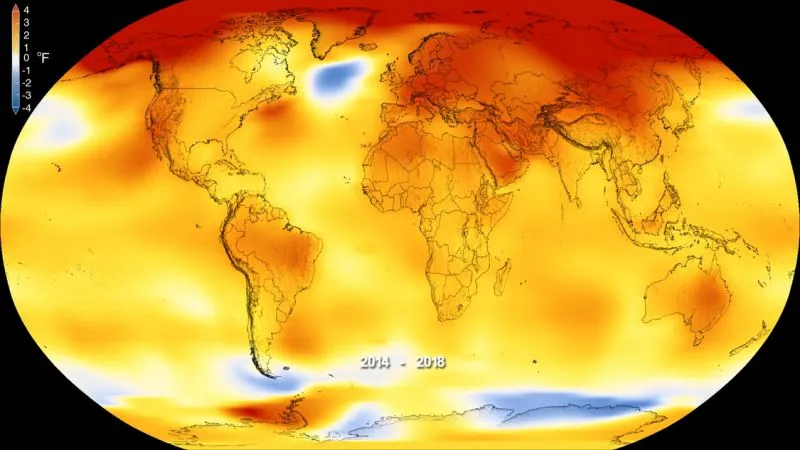Đây là nhận định tổng quan chung từ các cơ quan khí tượng từ Mỹ và Anh gồm hai cơ quan của Mỹ, văn phòng khí tượng Vương quốc Anh và Tổ chức khí tượng Thế giới.
Bốn cơ quan này đã phân tích nhiệt độ toàn cầu theo các cách khác nhau nhưng đều cùng đi đến kết luận: 2018 là năm nóng kỷ lục đi theo sau các năm 2016, 2016 và 2017.

Năm 2018 là năm thứ tư liên tiếp có nhiệt độ nóng kỷ lục. Ảnh: AP
Cơ quan quản lý nhiệt độ và mực nước biển quốc gia chính phủ Mỹ báo cáo nhiệt độ trung bình của năm 2018 là 14,69oC, nóng hơn nhiệt độ trung bình của thế kỷ 20 0,79 độ. Nhiều quốc gia Châu Âu đã ghi nhận nhiệt độ cao kỷ lục trong năm, con số có thể so sánh với hồi năm 1880.
Dù vậy các chuyên gia NASA và NOAA cũng nói năm 2018 có vẻ mát mẻ hơn so với ba năm trước đó, và đó chỉ là do sự thay đổi ngẫu nhiên của khí hậu.
Bằng việc sử dụng công nghệ mô phỏng trên máy tính, cơ quan dự báo khí tượng Anh dự báo năm năm tiếp theo nhiệt độ trung bình sẽ tăng lên khoảng từ 14,73oC đến 15,27 oC, cao hơn cả các năm trước đó.
Ngay cả chuyên gia bên ngoài khác như Natalie Mahowald của Đại học Cornell cũng nói dự báo này khá đồng nhất với những nghiên cứu của các nhà khoa học về sự nóng lên và sự biến thiên tự nhiên.
Xu hướng nóng lên ổn định được dự báo sẽ giúp cho việc dự đoán khả năng nóng lên trong thời gian gần chính xác hơn.
Điển hình cho việc nhiệt độ cao kỷ lục của năm 2018 là nước Mỹ, khi quốc gia này xếp thứ 14 trong số các quốc gia có nhiệt độ cao nhất. Đã có 14 thảm họa về khí hậu và thiên tai diễn ra tại nước Mỹ trong năm 2018, gây thiệt hại lên đến hơn 91 tỷ USD, làm ít nhất 247 người chết.
Thảm họa có mức thiệt hại kỷ lục nhất là cơn bão Micheal với 25 tỷ USD kế đến là bão Florence với 24 tỷ USD.
2018 was 4th warmest, but next 5 years could break records
(AP) — While 2018 was the fourth-warmest year on record, British meteorologists are predicting the next five years will be much hotter, maybe even record-breaking.
Two U.S. agencies, the United Kingdom Met Office and the World Meteorological Organization analyzed global temperatures in slightly different ways, but each came to the same conclusion Wednesday: 2018 was the fourth-warmest year on record behind 2016, 2015 and 2017.
The U.S. government's National Oceanic and Atmospheric Administration said 2018's average temperature was 58.42 degrees (14.69 Celsius), which is 1.42 degrees (0.79 Celsius) warmer than the 20th century average. Much of Europe had its warmest years on record. Records go back to 1880.
NASA and NOAA climate scientists said even though 2018 was a tad cooler than the three previous years that's mostly due to random weather variations.
"Never mind the little wiggles from year to year. The trend is going relentlessly up, and it will continue to do so," Potsdam Institute climate scientist Stefan Rahmstorf said in an email. "Those who live in denial of this fact are in denial of physics."
Using computer simulations, the British weather office forecast s that the next five years will average somewhere between 58.51 and 59.49 degrees (14.73 to 15.27 Celsius). That would be warmer than the last four years.
Outside scientists, such as Natalie Mahowald of Cornell University, said the forecast is consistent with what researchers know about warming and natural variability.
The obvious long-term trend of steady warming makes it easier to more accurately predict near future warming, said NASA chief climate scientist Gavin Schmidt.
The U.S. temperature in 2018 was the 14th warmest on average, said NOAA climate monitoring chief Deke Arndt.
Last year was also the third wettest on record in the U.S. Nine eastern states had their wettest years on record, "an exclamation point on a trend of big rain" in the age of climate change, Arndt said.
There were 14 weather and climate disasters that cost more than $1 billion, for a total of $91 billion, Arndt said. At least 247 people died in those disasters. That's the fourth-highest number of billion-dollar disasters and the fourth-highest dollar amount, taking inflation into account. The damage included Hurricane Michael's $25 billion tally and $24 billion each from Hurricane Florence and the western wildfires.

